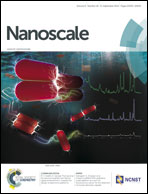A base-modified PNA–graphene oxide platform as a turn-on fluorescence sensor for the detection of human telomeric repeats†
Abstract
Given the biological and therapeutic significance of telomeres and other G-quadruplex forming sequences in human genome, it is highly desirable to develop simple methods to study these structures, which can also be implemented in screening formats for the discovery of G-quadruplex binders. The majority of telomere detection methods developed so far are laborious and use elaborate assay and instrumental setups, and hence, are not amenable to discovery platforms. Here, we describe the development of a simple homogeneous fluorescence turn-on method, which uses a unique combination of an environment-sensitive fluorescent nucleobase analogue, the superior base pairing property of PNA, and DNA-binding and fluorescence quenching properties of graphene oxide, to detect human telomeric DNA repeats of varying lengths. Our results demonstrate that this method, which does not involve a rigorous assay setup, would provide new opportunities to study G-quadruplex structures.


 Please wait while we load your content...
Please wait while we load your content...